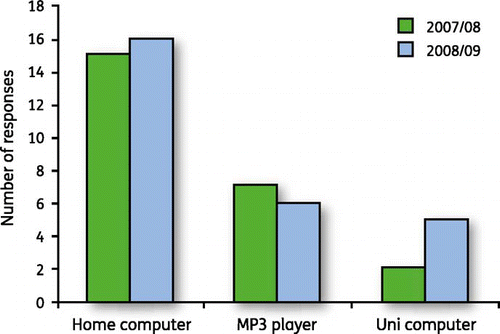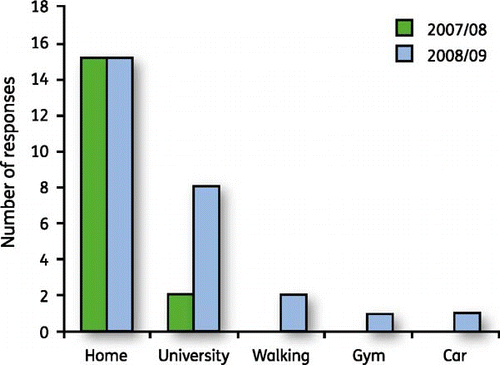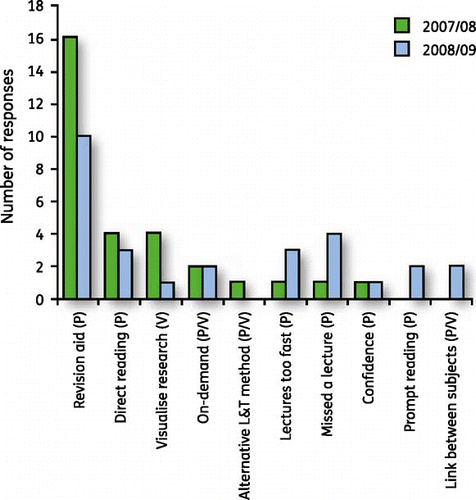Abstract
The development and spread of second-generation internet technologies has led to a rapid increase in the number of lectures being recorded and podcast (audio cast) or vodcast (video cast) to students. This study discusses a podcast and vodcast trial delivered to Level 3 BSc Geography students at the University of Leeds during 2007/08 and 2008/09 to ascertain the value of the process for learning. The majority of students reported using podcasts and vodcasts whilst sat at computers either at home or at university. Students reported several perceived benefits from podcasts including their use as a revision aid and a tendency towards more reading of the literature. Students were fully supportive of the podcasting experience and suggested useful ideas for improvements for future podcasting initiatives.
Introduction
The current generation of students entering higher education, imaginatively described as ‘digital natives’ by CitationPrensky (2001), have been surrounded by digital technology for most of their life so far. They use a range of Web 2.0 technologies (e.g. wikis, social networking sites, media-sharing tools such as podcasts) in their personal lives on a day-to-day basis (CitationDede, 2005). These perceptions about students' use of new web technology, coupled with suggestions about the potential educational benefits of these new media platforms, have underpinned a recent drive for their integration into higher education (e.g. CitationManning, 2005; CitationCebeki & Tekdal, 2006; CitationTerdiman, 2005). However, there is still only minimal evidence that students derive any real learning benefits from the incorporation of these technologies into educational practice (CitationDownes, 2004; CitationBelanger, 2005; CitationMorrison & Bowen, 2006).
Podcasts (audio casts) and vodcasts (video casts) have become widely used over the last five years, with the number of users expected to increase rapidly over the next decade (CitationGilbert, 2005). Podcast and vodcast content is distributed over the internet for download and use with mobile digital audio/video players such as MP3 players and mobile phones (CitationCebeki & Tekdal, 2006), and accessed online with appropriate software. The use of audio and video recordings as learning tools is by no means new (e.g. CitationKozma, 1991) but it has been suggested that delivery of these media through podcasts and vodcasts may have several potential educational benefits (CitationBelanger, 2005; CitationCampbell, 2005) including: (1) lectures no longer have to be confined to the classroom at a specified time; (2) learning and teaching can become mobile (i.e. podcasts listened to when people are travelling); (3) students are able to revisit material as often as required for revision, potentially facilitating deeper, on-demand learning, and; (4) empowerment of students who struggle with the pace of lectures. Further evaluation is required to assess the benefits that students may gain from the adoption of these novel approaches to delivering study material.
This case study evaluates a podcast and vodcast trial delivered to groups of Level 3 BSc students in the School of Geography, University of Leeds, during the 2007/08 and 2008/09 academic years. Podcasts were used to deliver recordings of lectures and discussions about the relevance of specific reading list items. Vodcasts were used to visually illustrate selected key publications from the reading lists. Specific aims of the study were to:
evaluate the methods used by students to accessand listen to podcasts or view vodcasts;
consider the extent to which students took opportunities to listen to podcasts whilst on the move as opposed to sat at a study desk in university or at home, and;
discuss some of the perceived benefits of podcast and vodcast resources among those studying Geography.
A case study of podcasts and vodcasts for a module on River Ecosystems
Learning and teaching context
The Level 3 elective module GEOG3022 River Ecosystems is primarily delivered to students studying for BSc Physical Geography but also attracts students from Environmental Science and Biology departments. Enrolment was 25 students for both years. The module has six x two hour lecture/discussion classes, two x two hour data analysis practicals and two x two hour student-led presentation sessions. It was assessed in both years by a written data analysis report (40%), group presentation (10%) and exam (50%). The module was chosen for the podcast and vodcast trial because its content is directly related to the author's research activities, making it easy to generate relevant resources. Some students in other modules had suggested they have difficulty in listening, making notes and keeping up with the pace of lectures, so podcast provision was also seen as a good opportunity to provide time to listen, think and digest information on-demand (see also CitationBelanger, 2005; CitationCampbell, 2005). No announcements regarding the podcasting trials were made before the modules started to ensure students enrolled for academic interest reasons as opposed to curiosity regarding alternative pedagogical approaches.
Podcast and vodcast resource development
The podcasts and vodcast trial was introduced to the students during lecture 1 of both academic years by means of a written handout and a short presentation. Resources were introduced from the start of the course in an attempt to ensure that student study learning habits were framed from the outset (CitationBerger, 2007). Podcasts and vodcasts were uploaded to the School of Geography web-server with an associated Really Simple Syndication (RSS) feed for subscription using an aggregator (software that automatically reads RSS feeds and downloads associated files; e.g. iTunes). In addition to the RSS option, students could access files via an aggregator embedded in the University of Leeds' Virtual Learning Environment (VLE), or by direct download from the web server. Students were reminded about the availability of the resources during lectures and by email throughout the module.
Resources were created for each of the six lecture slots, and three approaches were adopted:
Recordings of one-hour lectures were made during class. Immediately after the lecture, the recordings were edited using Audacity v1.2.6 to produce \R~10 minute podcasts that focused specifically on the key points covered in the lecture. This decision was based on a suggestion by CitationCebeki & Tekdal (2006) that longer podcasts might lead to a loss of attention in listeners. However, some students requested the full lecture recordings, so complete recordings were uploaded alongside the shorter digests.
Five to ten minute recordings were made to complement the reading list for each lecture. These audio recordings included brief discussion of the merits of each selected publication, some of the key findings, and how the publication was relevant to the lecture content. It was anticipated that these podcasts would encourage the students to read more supplementary texts once they were able to appreciate the reasons for their inclusion on the reading list.
Videos of between five to ten minutes supplemented three of the six module lectures. Initial plans were to provide one vodcast per lecture but time constraints during filming and production led to a scaling back of this objective. High-quality footage was captured using a digital video camera during summer 2007 fieldwork. Each video provided a visual overview of the subject matter corresponding to a recommended journal paper to illustrate the work of key thinkers in the field. It was anticipated that these video resources would allow students to engage with the journal paper content by providing a visual experience around which ideas could be framed.
Podcast and vodcast resource evaluation methods
The number of students was monitored throughout the lecture series to assess whether podcast provision served as a disincentive to attendance. A survey of student opinion regarding the introduction of podcasts and vodcasts was carried out after the last lecture of each year. Questionnaires were distributed in-class and collected as students left to ensure high response rates were obtained. Students were asked the following open questions to assess usage (Q1\2-3) and the perceived educational benefits (Q4):
How did you access the podcasts and vodcasts?
What devices did you use to listen to the podcasts and vodcasts?
Where did you listen to the podcasts and vodcasts?
What benefits did you gain from listening to the podcasts or watching the vodcasts?
Students were also asked to suggest improvements for future podcasting initiatives. In total, 18 responses (72%) were obtained in 2007/08 and 22 responses (88%) in 2008/09. Follow-up discussions were held with 3\2-5 selected tutees each year. Whilst these respondents were not randomly selected, they offered balanced views (i.e. positive and negative comments) and were considered to be providing views representative of the cohort, as most admitted to conveying both their own and their peers' ideas. Despite the small total number of respondents, the results serve as a useful reference point for further studies and discussion of Geography students' uses and perceptions of podcasts and vodcasts.
Study findings and discussion
Student attendance at lectures was consistently above 80%, substantiating earlier studies that student attendance shows little or no reduction following podcast provision (CitationBrittain et al., 2006; CitationLane, 2006). Most respondents said that they had accessed and used some, if not all, of the podcast and vodcast resources. The majority of students on both courses accessed and downloaded files through the VLE, with only a handful choosing to use a third-party aggregator such as iTunes (). Access log files from the VLE confirmed these findings and showed repeat visits from most students. Several students explained that they preferred the VLE option due to ‘ease of access’ and a reluctance to learn how to use aggregator software. Most students failed to realise that accessing resources through the VLE was the most long-winded route on offer, requiring log in and navigation through eight web pages. For the cohorts in this study there appeared to be a knowledge divide between knowing how to access podcasts and understanding the technology associated with their efficient delivery.
Almost all respondents on both courses said that they had used a desktop computer or laptop to listen to podcasts or watch vodcasts at home (). A small proportion of these students had also used computers at university to engage with the material, whilst approximately 1/3 had used an MP3 player to listen to podcasts. No students suggested that they had used mobile phones to listen to podcasts, and mobile video players had not been used by any student to watch the vodcasts. Together, the findings of this and other studies suggest that the full potential of mobile devices for learning and teaching is not yet being realised by these students. Verbal feedback from some students indicated that they did not own the necessary technology (e.g. personal MP3 players, mobile video players; see CitationKurtz et al., 2007 for similar results). Of the students who reported the use of mobile MP3 players, many had chosen not to take advantage of the potential for learning on the move, with the podcast and vodcast resources predominantly being used only at home or at university as part of study (). This shows that the potential for mobile learning (CitationNaismith et al., 2004) was only realised among a select number of Geography students, similar to findings of podcast evaluations in other subjects (CitationLane, 2006). Verbal feedback from students with MP3 players suggested a preference to relax and listen to music rather than study when travelling, or that transport was often too hectic for meaningful study. Some students also reported a desire to make notes whilst listening to podcasts, something that is often impossible whilst on the move (CitationStrayer and Johnston, 2001). Students therefore typically chose to listen to educational podcasts during study periods when they had no other commitments. Students perceived a range of benefits from the provision of podcasts and vodcasts () but none of these were specifically related to the technological benefits of podcasting. Recording lectures for review is not a new concept, having been practiced for many years, and students reported similar benefits to the provision of audio from previous audio/video initiatives (CitationDeal, 2007). For example, podcast resources were most useful as a review tool, e.g. for exam revision, and where a lecture, or part thereof, had been missed. Some authors have suggested that students may over-estimate the usefulness of reviewing recorded lectures and this may draw effort away from more effective study strategies (CitationDeal, 2007). However, students who missed lectures clearly found the podcast resources an effective way to catch up on their study. The online availability of podcast recordings meant that students who missed a lecture could obtain the recording and did not have to compromise their learning. Four students in total reported benefits from being able to review lectures at a slower pace, and one overseas student used them to transcend a language barrier, emphasising the role of audio recordings for widening participation. Seven students suggested that the podcasts inspired them to do further reading, which was a novel finding linked to the reading list podcasts developed exclusively for this study. Whether or not these various perceived benefits translated into positive educational outcomes remains unknown. It was beyond the scope of this trial to measure student performance in a controlled environment.
Summary
Although detailed evaluations of podcasts and vodcasts in higher education are just beginning to emerge, the results of this study for Geography students show similar tendencies towards listening to podcasts on computers and at home as previously seen for Dentistry, Computer Science, Oceanography and Politics students (CitationBrittain et al., 2006; CitationLane, 2006; CitationMalan, 2007). Mobility and flexibility of listening are often cited arguments for the podcasting of recorded lectures (CitationDeal, 2007) so it is perhaps surprising that students across different academic disciplines are employing similar ‘stationary’ study strategies. The feedback from these Geography students is that they prefer to relax when travelling. They like to study in a quiet location with no other distractions and want to take notes whilst listening. This lends support to the notion that students are not engaging with the possibilities afforded by podcasts and MP3 players for mobile education at present. However, the wider applicability of these findings clearly needs to be substantiated through comparative studies directed at larger cohorts with identical methods employed across academic disciplines.
The students who took part in this trial were largely supportive of the podcast and vodcast initiative and made several suggestions for improvements for future podcasting and vodcasting projects. These included the provision of a script to accompany the podcast; more and longer vodcasts, podcasts accompanied by lecture slides in one combined file and additional podcasts which offer summaries of the most complex tables and figures from recommended research papers. Additionally, and as seen in earlier studies (CitationLane, 2006), many students suggested that they would like to see podcasting rolled out across all their university modules. This can be taken as a clear indication that students are keen for universities to embrace new technological approaches to delivering information. However, it remains to be seen whether this approach to information provision can enhance the learning experience in cohorts of students.
Acknowledgements
This study was made possible by a University of Leeds, Faculty of Environment, Teaching Quality Enhancement Fund (TQEF) award. Alison Heppenstall helped with the TQEF application and initial project development. David Appleyard assisted with website development. Steve Carver, Jonathan Carrivick, Melissa Highton and John Bradbeer provided helpful comments on an earlier version of the manuscript.
References
- BelangerY. 2005 Duke University iPod first year experience final evaluation report. asp?document=http%3A%2F%2Fcit%2Eduke%2Eedu%2Fpdf%2Fipod%5Finitiative%5F04%5F05%2Epdf+html/offsite. Accessed 5 January 2011
- BergerE. 2007 Podcasting in Engineering education: A preliminary study of content, student attitudes, and impact, Innovate: Journal of Online Education 4 (1)
- BrittainS., GlowackiP., Van IttersumJ. and JohnsonL. 2006 Podcasting lectures, EDUCAUSE Quarterly, 29, 24–31
- CampbellG. 2005. There's something in the air: Podcasting in education, EDUCAUSE Review, 40, 32–47
- CebekiZ. and TekdalM.2006 Using podcasts as audio learning objects, Interdisciplinary Journal of Knowledge and Learning Objects 2, 47–57
- DealA. 2007 Podcasting: A teaching with technology white paper, Office of Technology for Education & Eberly Center for Teaching Excellence, Carnegie Mellon University. http://connect.educause.edu/files/CMU_Podcasting_Jun07.pdf Accessed 5 January 2011
- DedeC. 2005 Planning for neomillenial learning styles, EDUCAUSE Quarterly, 28, 7–12
- DownesS. 2004. Educational blogging, EDUCAUSE Review, 39, 14–26
- GilbertA. 2005 Researcher sees huge growth in podcast audience, CNET News.comnews://News.com. July 6. http://Researcher+sees+huge+growth+in+podcast+audience/2100-1025_3-5777201.html?tag=itemnews.com.com/ Accessed 5 January 2011
- KozmaR.B. 1991 Learning with media, Review of Educational Research, 6, 179–211
- KurtzB.L., FenwickJ.B. and EllsworthC.C. 2007 Using podcasts and tablet PCs in computer science, Proceedings of the 45th Annual Southeast Regional Conference: 484–489
- LaneC. 2006 UW Podcasting: Evaluation of Year One. Report by Office of Learning Technologies, University of Washington. http://www.washington.edu/lst/research_development/papers/2006/podcasting_year1.pdf Accessed 5 January 2011
- MalanD.J. 2007 Podcasting computer science E-1, Proceedings of the 38th SIGCSE Technical Symposium on Computer Science Education; 389–393
- ManningS. 2005 The promise of podcasting, Pointers & Clickers, 6(2). Retrieved November 24 2006, from: http://www.ion.illinois.edu/resources/pointersclickers/2005_03/Podcasting2005.pdf
- MengP. 2005 Podcasting and vodcasting: Definitions, discussions and implications, White Paper prepared for the University of Missouri. http://www.tfaoi.com/cm/3cm/3cm310.pdf
- MorrisonJ.L. and BowenD.F. 2006 Taking a journey with today's digital kids: An interview with Deneen Frazier Bowen, Innovate: Journal of Online Education 3, 4
- NaismithL., LonsdaleP., VavoulaP. and SharplesM. 2004 Literature review in mobile technologies and learning, NESTA Futurelab Report: Series 11, NESTA Futurelab, Birmingham
- PrenskyM. 2001 Digital natives, digital immigrants, On the Horizon 9, 5, 1–6
- StrayerD.A. and JohnstonW.A. 2001 Driven to distraction: Dual-task studies of simulated driving and conversing on a cellular phone, Psychological Science 12, 462–466
- TerdimanD. 2005 Stanford using iTunes to take lectures global, News.com. November 3, 2005. http://news.cnet.com/2100-1041_3-5931232.html Accessed 5 January 2011



